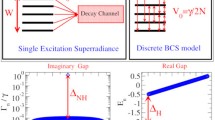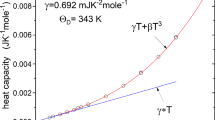Abstract
It is shown that, in the conventional superconductors, there exist in addition to the discontinuous excitation spectrum of the BCS-theory, continuous (gap-less) excitation spectra due to bosons. Since above and below the transition temperature, TSC, the heat capacity of the superconducting elements exhibits power functions of absolute temperature, T = 0 is the only critical point. The superconducting transitions therefore are all within the fairly large critical range at the critical point T = 0. Typical of a critical range is short-range order. At TSC, the type of short-range order changes. While above TSC, the type of short-range order is not quite clear, the short-range ordered units below TSC are the Cooper-pairs. The observed power functions of absolute temperature result from the fact that the generally gap-less excitation spectra of the ballistically propagating bosons are given by simple power functions of wave-vector. As we know from Renormalization Group (RG) theory, in the vicinity of a critical point, including the critical point T = 0, the atomistic interactions are excluded from the dynamics. The gapped excitation spectrum of the Cooper-pairs is a typical atomistic excitation that is not relevant for the boson-defined zero-field heat capacity. It can reasonably be assumed that the relevant bosons below TSC are identical with the bosons giving rise to the universal linear-in-T electronic heat capacity above TSC, as it is typical for all metals. Ordering of these bosons at TSC entails the formation of Cooper-pairs. Arguments will be given that the bosons have to be identified with electric quadrupole radiation, generated by the non-spherical charge distributions in the soft zones between the metal atoms.







Similar content being viewed by others
References
R. Kleiner, W. Buckel, Superconductivity: An Introduction (Wiley-VCH, Weinheim, 2016)
K.G. Wilson, J. Kogut, Phys. Rep. 12C, 75 (1974)
U. Köbler, J. Magn. Magn. Mater. 453, 17 (2018)
U. Köbler, J. Magn. Magn. Mater. 546, 168839 (2022)
U. Köbler, VYu. Bodryakov, Int. J. of Thermo. 18, 200 (2015)
P. Heller, Rep. Prog. Phys. 30, 732 (1967)
R.K. Pathria, Statistical Mechanics, 2nd edn. (Butterworth-Heinemann, Oxford, 1996)
A. Hoser, U. Köbler, Acta Phys. Pol. A 127, 350 (2015)
J. Goldstone, A. Salam, S. Weinberg, Phys. Rev. 127, 965 (1962)
C.J. Pethick, H. Smith, Bose-Einstein Condensation in Dilute Gases (Cambridge University Press, 2008)
U. Köbler, Int. J. of Thermo. 18, 277 (2015)
U. Köbler, Int. J. of Thermo. 20, 210 (2017)
W.S. Corak, M.P. Garfunkel, C.B. Satterthwaite, A. Wexler, Phys. Rev. 98, 1699 (1955)
U. Köbler, A. Hoser, Experimental studies of Boson fields in solids (World Scientific, Singapore, 2018)
U. Köbler, Int. J. of Thermo. 23, 59 (2020)
C.B. Satterthwaite, Phys. Rev. 125, 873 (1962)
J. Bardeen, L.N. Cooper, J.R. Schrieffer, Phys. Rev. 108, 1175 (1957)
U. Köbler, Int. J. of Thermo. 24, 238 (2021)
W. Meissner, R. Ochsenfeld, Naturwissenschaften 21, 787 (1933)
B.J. Van Der Hoeven Jr, P.H. Keesom, Phys. Rev. 137, A103 (1965)
Ch. Enss, S. Hunklinger, Low-temperature physics (Springer, Berlin, 2005)
J.E. Neighbor, J.F. Cochrane, C.A. Schiffman, Phys. Rev. 155, 384 (1967)
C. Kittel, Introduction to solid-state physics (Wiley, New-York, 2005)
B.J. Van der Hoeven Jr, P.H. Keesom, Phys. Rev. 135, A631 (1964)
B.J. Van der Hoeven Jr, P.H. Keesom, Phys. Rev. 134, A1320 (1964)
H.A. Leupold, H.A. Boorse, Phys. Rev. 134, A1322 (1964)
N.E. Phillips, Phys. Rev. 114, 676 (1959)
A.M. Okaz, P.H. Keesom, Physics 69, 97 (1973)
N.E. Phillips, Phys. Rev. Lett. 1, 363 (1958)
R. Radebaugh, P.H. Keesom, Phys. Rev. 149, 209 (1966)
N.E. Phillips, Phys. Rev. 134, A385 (1964)
D. White, C. Chou, H.L. Johnston, Phys. Rev. 109, 797 (1958)
J.R. Clement, E.H. Quinnell, Phys. Rev. 92, 258 (1953)
H.R. Oneal, N.E. Phillips, Phys. Rev. 137, A748 (1965)
U. Köbler, Int. J. of Thermo. to be published
P.I. Richards, M. Tinkham, Phys. Rev. 119, 575 (1960)
B. Mühlschlegel, Z. Physik 155, 313 (1959)
U. Köbler, Int. J. of Thermo. 23, 147 (2020)
C. Probst, J. Wittig, Phys. Rev. Lett. 39, 1161 (1977)
U. Köbler, J. Magn. Magn. Mater. 551, 169129 (2022)
Acknowledgements
I express my deep respect to all of the ingenious experimentalists who have measured the high-precision superconducting heat capacity data that were a condition for the here achieved better understanding of the phenomenon of superconductivity.
Author information
Authors and Affiliations
Corresponding author
Additional information
Publisher's Note
Springer Nature remains neutral with regard to jurisdictional claims in published maps and institutional affiliations.
Rights and permissions
Springer Nature or its licensor (e.g. a society or other partner) holds exclusive rights to this article under a publishing agreement with the author(s) or other rightsholder(s); author self-archiving of the accepted manuscript version of this article is solely governed by the terms of such publishing agreement and applicable law.
About this article
Cite this article
Köbler, U. New Explanation of the Excitation Spectra of Conventional Superconductors. J Low Temp Phys 210, 113–128 (2023). https://doi.org/10.1007/s10909-022-02886-7
Received:
Accepted:
Published:
Issue Date:
DOI: https://doi.org/10.1007/s10909-022-02886-7




